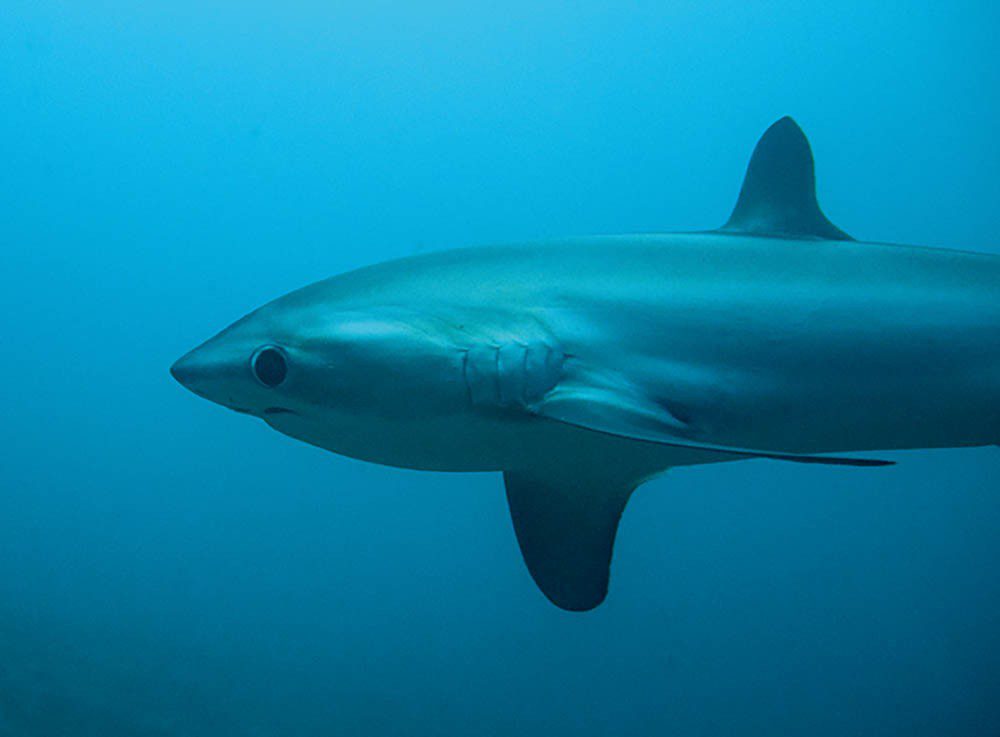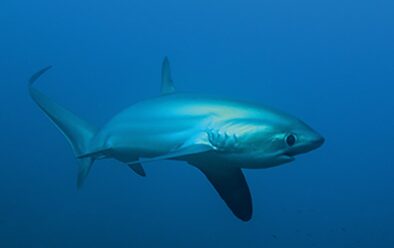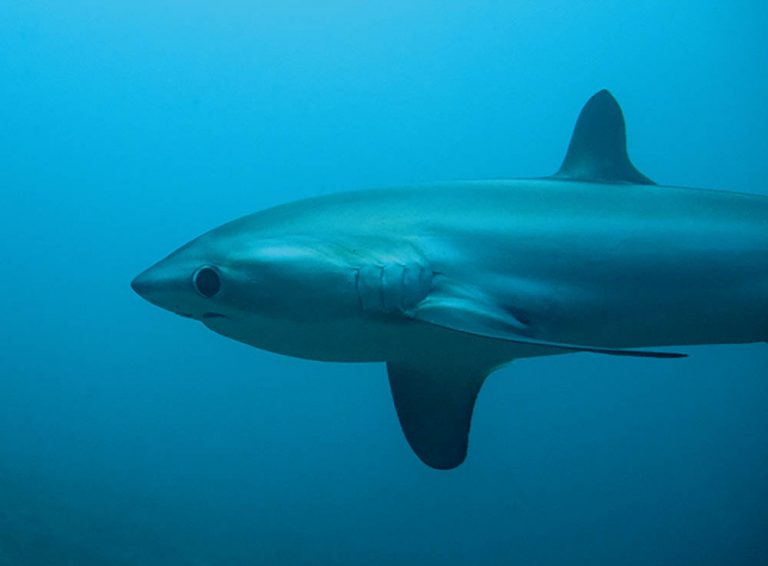PHILIPPINES DIVER
All Creatures Great and Small
CATH BATES heads for Malapascua for a series of early starts to see the famous thresher sharks, and finds that technical diving gives the world-famous location a whole new dimension (and it already had quite a few!)

“THE WORLD IS A BOOK, and those who do not travel read only a page,” said St Augustine. Having previously visited only two of the 7000 Philippine islands, I thought it was time to open the next chapter of that book – and visit the famous “Shoals” of Malapascua.
I was also concerned that my partner might leave me if I continued to take him on holidays where the biggest marine life creature we saw was no bigger than a fingernail…
I chose the Evolution Resort, because it professed to offer “progressive recreational and technical diving”. As an avid underwater photographer and old technical-diving instructor, I figured that it should be able to satisfy most of my whims.
Evolution is run by TDI Instructor-Trainer Matt Reed and business partner David Joyce. This basic but friendly 5* PADI resort satisfied not only my diving wishes but also kept my stomach happy (at the Irish-hospitality Craic House bar) and satisfied my desire to minimise my carbon footprint as a tourist (at the Asian dive show ADEX this year, Evolution was voted Dive Operator with the Lowest Impact on the Environment Worldwide).
The best sites of Malapascua can be slotted into three categories: beautiful, fluffy soft coral bommies with a mixture of macro and wide-angle joy; muck/sandy bottoms for critters; and the Shoals – underwater islands with large pelagic life.
Four-in-the-morning starts are both exhilarating and tiring, but when you see the molten-lava skies as the sun rises, you’ll want to get up early over and over again. Oh yes, and those funny-looking sharks with the long tails and bug-eyes help too!
As you descend towards Cebu you can make out the Shoals from the aircraft. They look like reefs, but they aren’t islands because they don’t reach the surface.
Monad Shoal is east towards Leyte and takes 30 minutes to reach from Malapascua. It is just under a mile long, and divers have been looking out here for the pelagic threshers (the smallest of all the threshers at 3m) for about 15 years.
Thanks to the maintenance of a healthy respect for the distance between divers and cleaning stations, shark numbers don’t seem to have diminished in that time.
Appeared in DIVER August 2018
THE EVOLUTION MOORING is in a great location. You can swim left to the many cleaning stations, or right to the sandy slope that one of our guides called the Highway. Left is busy but offers more opportunity; on the right side threshers tend to be passing through, but it was here that we also saw juveniles on a shallow 14m plateau.
I guess this was the shark equivalent of a service station where the teenagers came to hang out, recharge their batteries and get their bodywork pimped!
Divers are encouraged to hover horizontally or fin-pivot behind the strategically placed ropes to avoid disturbing the cleaning station. If the reef is ruined the cleaner wrasse won’t come to feed, and the threshers won’t have a beauty parlour any more.
So why the early start? Thresher sharks exhibit something called “vertical migration” – they come up to shallow water at night but live deep during the day. Therefore, we have to fit into their rather unsociable schedule before the sun comes up.
The bottom of Monad Shoal is in the 200m Mesopelagic Zone, where light is poor. Threshers have huge eyes that they can rotate upwards, making hunting easier at depth, but they can’t blink, so their eyes are very sensitive to strobe lights (use of which is not allowed).
They use their large tails to stun schooling fish by slapping them in the water column, and have often been seen breaching as they do this, or during a cleaning frenzy.
Their Greek name Alopias means fox, and there is definitely something foxy about their big eyes and small mouths.

As the threshers pass they eyeball you, gliding past effortlessly steering a course on broad pectoral fins. The view I shall always remember, however, is that of them swimming away into the blue – the slender caudal fin (nearly half the length of the shark!) snaking from side to side.
As the sun rose higher in the sky their bronze flanks caught the light, giving the impression of living sculptures.
We visited Monad eight times and saw sharks every time. The guides will tell you that sightings are not guaranteed, but with between 3-9 individuals on each dive, we were happy to continue to leave the comfort of our bed!
At Gato Island you could almost see the corals photo-synthesising, absorbing the light and scoring energy points like coloured sweets in a game of Candy Crush. The reef pulsated with life.
Gato Island is classed as a day-trip. You leave the centre at approximately 9.30 and head out north-west of Malapascua to a grassy seamount 50 minutes away by outrigger. Lunch slots into the surface interval.
A 50m-long tunnel cuts through it from one side to the other, which makes for a dramatic start to your dive. We scanned the cave with our torches for sleeping whitetips and found one huge specimen at the entrance to the second tunnel, looking threateningly like a bouncer.
A remora scuttled over its back manically as the whitetip’s mouth opened and closed. I could imagine it saying:
“If your name’s not down, you’re not coming in…” A school of mackerel flitted left and right at the exit, their jaws open in a permanent scream as they played cat and mouse with a giant trevally. To our left was the island reef; to our right, giant boulders adorned with soft pink and mauve broccoli corals. On and around them were pharaoh cuttlefish, Clark’s anemonefish and ghost pipefish.
A vain hawkfish situated itself at the base of one of the coral trees, sporting it like the tail of a peacock. It conjured up images for me of the Folies Bergère! The fauna was as ostentatious as the costumes of the Moulin Rouge, thanks to the currents of the open sea moving around this shallow island.
As we ascended along the wall we saw thorny seahorses, dwarf cuttlefish, Glossodoris and broad-banded pipefish. Looking down at the seabed, the honeycomb and granular seastars looked like cushions scattered randomly in a gaudy bedroom.
CHOCOLATE ISLAND, south-west of Malapascua, really was the icing on the cake. Like candy in a selection box, its top poked out of the Visayan Sea, concealing a soft centre of fluffy pink coral mousse!
As we arrived in mid-afternoon, herons swooped to pluck minnows from beneath the surface. I took this as a good omen for what lay beneath!
At a depth of around 5-8m, broccoli, xenia and daisy corals danced in the swell. Gobies scooted up and down their fragile whip-coral slides like kids on too much fizzy pop, while clown anemonefish made me dizzy playing hide-and-seek inside a leather anemone.
As a contrast, on the shallow plateau surrounding the island a “racing-stripe flatworm” failed to live up to its name, and a motionless double-snouted spindle cowrie lay motionless, camouflaged into a tightly meshed whip.
I marvelled at the density of other coral species as we ascended back into the shallows. Encrusting sheet corals merged into leather coral which became organ-pipe, bubbly honeycomb and hammer coral.
It made perfect sense that this area was Evolution’s choice for night dives.
At both of the above sites there were statues of the Virgin Mary. Evolution and some of the other local dive-centres are placing these under water to discourage dynamite-fishing.
Bugtong Batu is a pinnacle that rises from 30m at the seabed to 13m below the surface. It is recommended as a nitrox dive, because you gradually snake your way up around the pinnacle and then spend some time on the top enjoying the diverse marine life below you.
This was a spectacular dive for observing fish behaviour. At this time of year, lemon damselfish are guarding the eggs they have laid on the multitude of whip corals that adorn the pinnacle.
This gave me a good opportunity to shoot the vibrant blue lines across their fins and on their face and eyes.
Banded boxer shrimp busied away cleaning a lionfish, and an irritated pufferfish tried to dislodge a sea cucumber it had swum into, by rubbing itself against crinoids and broccoli coral.
Larger pelagic fish such as schooling batfish swam around the massive purple gorgonian and black coral seafans, while pink-spotted nudibranchs and a Miller’s Nembrotha kept the macro lovers happy among the crinoids and carpet anemones.
The local muck-sites required some more effort to find life, but the guides are adept at this. The Evolution house reef is a short boat-ride from the beach.
After being asked to find us a blue-ringed octopus, Gino’s Knight Rider eyes were scouting the seagrass like the scanning light on Kit’s bumper!
A boat, bamboo structures and some toilet bowls (all placed there by the resort team) have started to show coral growth and are creating interesting habitats for lionfish, eel catfish and glassfish. A fire-worm flitted around two nose-to-nose sea moths, and carpet anemones unfurled in the gentle water movement to reveal delicate porcelain crabs hiding under tentacle skirts.
On the bottom we marvelled at colourful sea-apples, sea-pens, a moon-snail egg-casing and hermit crabs fighting over a new shell domain. Well-buried sand-eels gazed vertically up to the unachievable surface ripples.
As we gave the thumbs-up signal to leave the 1m sandy bottom, Gino squealed through his reg. He had seen the holy grail: a blue-ringed octopus.
This little fellow was some 7cm long. We watched as it changed shape and stretched out its tentacles to walk along the green seabed.
It flashed the blue rings as a threat but also attempted to camouflage itself in among the fauna by spiking up to look like a fern in the seagrass.
Deep Slope – a sandy slanting bottom joining a reef top – was my favourite muck-site. We descended a line to a small purple gorgonian seafan. Guide Joe pointed out a Bargibanti seahorse just a few centimetres in length.
This one was coy and it was hard to focus on such a tiny critter inside the purple branches of the fan. I was impressed that our guides didn’t use pointy sticks to influence the pygmy seahorse’s position and – as there was a queue behind me to see it – I decided to move on, safe in the knowledge that this was going to be a good dive.
THE GREENS, BLUES AND REDS of the mantis shrimp make them a great subject for photography, but I’m always a little unsure how close to get, aware that they have been known to smash aquarium glass with their powerful claws! This 400-million-year-old life-form tends to live most of its life in burrows, venturing out only to spear or strike prey.
I happily snapped away at porcelain crabs and bubble-anemone shrimp, only to curse my macro lens when we ascended to the reef top to find both orange and white giant frogfish. The white one “yawned”, which was its way of telling me to bugger off or it would eat me!
When frogfish do this, they can increase the size of their mouths by up to 12 times. I took the hint and finned away with my 60mm lens between my legs. I found a much less threatening striking purple Hypselodoris laying eggs just a few metres away.

Technical diving is big at Malapascua. The local sites are perfect for practising skills on courses and the drop-offs of the shoals have both depth and the reward of pelagics. During our stay there were normoxic trimix, Pelagian CCR and air deco courses on the go.
The tec room is well-equipped for preparing twin-sets and rebreathers and there are also trimix blending facilities. My buddy and I dived with two very skilled and attentive technical instructors who didn’t have one inflated ego between them.
The consistency in procedures was comforting, and pre-dive planning and safety briefings were thorough but relaxed. Blended gases were spot on, logging and labelling was encouraged and spare gas always available on board.
Boat-crew were well-briefed with what they should and shouldn’t help you with but were always there when you boarded the boat to help you de-kit.
The tiny Filipino crew made carrying both twin-sets and J-tanks up and down the beach on their shoulders look effortless!
Monad Shoal has many different wall-diving options for technical diving, going under the cleaning stations and ascending by dramatic overhangs.
As well as the possibility of seeing some straggling thresher and hammerhead sharks and devil rays, the topography of big purple gorgonian and large rock outcrops was impressive.
MACKLIN’S MOUND (south side) and Devil Ray Corner (north side) were easy but spectacular multi-level deep-air dives.
The Mogami Maru is a Japanese fishing trawler that sank in 1944. She was bombed by air and went down north of Malapascua island to her watery grave at 50m. It’s a perfect entry-level trimix dive.
The wreck’s 50m length meant that we were to explore her over two dives.
Guide Dannie donned his drysuit, and my buddy and I exchanged confused glances. At the beep of the GPS the crew dropped anchor, and we used that line to descend in quite a current.
Thankfully, after just the initial shiver through a thermocline, the bottom temperature settled at 27°!
On the first dive we explored the destroyed stern and midships, taking in the telegraph, mast, engine-room and winches.
Dannie showed us where they have hidden artefacts found on the wreck so that they can be seen by divers without being at risk of theft. We saw crockery marked with a blue flower and Japanese text, the handle of a jug, staghorns (perhaps from an animal or an ornament from the captain’s cabin), locks and keys all covered in verdigris, thigh bones (men did die in the explosion) and a huge heavy glass sphere that was probably housing the ship’s compass.
The ascent on this dive was challenging. With the strong current, a heavy camera and somewhat disorientating bluewater drift-deco, I was happy to hit the surface. However, I was itching to get back on the wreck later in the day to see what the bow looked like.
Although the water was greener, slack tide gave us a much more enjoyable second dive, and we were able to appreciate more of the marine life.
The bow was covered in cigar sponges, and glassfish schooled in the forward bow. An army of shrimps escorted us around the cargo hold and their translucence lit up in the beams from our torches. Huge bohar snapper guarded the remains of the anti-aircraft gun.
The anchor windlasses still have the Mogami Maru tied at anchor on port and starboard. Dannie showed us the pressure gauge and some gas-mask canisters just before we gave the up signal to begin our (much easier) gas-switches and drift-deco.
WHAT SET EVOLUTION APART for me was the skill of the dive-guides, including the locals. They have all received technical technique training from the owners, and all display impeccable trim and finning techniques so as not to disturb the bottom; they wear backplates, wings and harnesses and short-blade technical fins. They stood out from all other dive-centre guides we saw.
Evolution makes a point of checking tide times to ensure that you see the best sites at the best times. The hosts are welcoming and not one member of the team looked tired or unhappy at 4.30am!
Boats were well-equipped and sizeable, with clever names such as the Haldane and Beagle (Charles Darwin’s ship).
All these small details and more made the biggest difference in creating a resort built by divers for divers. rEVOLUTIONary…
FACTFILE
GETTING THERE> Cath travelled with Cathay Pacific to Hong Kong in 12 hours, followed by a 50min transit and a further 2hr 45min to Cebu. A three-hour car journey took her to the small port where a boat was waiting to take her over to Malapascua in 45min.
DIVING & ACCOMMODATION> Evolution has 16 rooms, either Ocean, Beach and Standard Deluxe Air-con or Garden Fan, all with hot showers. Deluxe rooms also have a terrace, room safe, complimentary water, tea and coffee, mini bar and TV with video library. Wi-fi is available. The dive centre has two large outrigger boats and three skits and can supply nitrox, evolution.com.ph
WHEN TO GO> November to May are the driest months, with 26-29°C water temperatures. 3mm wetsuits recommended.
MONEY> Filipino pesos on Malapascua, especially if you venture out of the resort because there are no ATMs on the island. Diving and accommodation are best paid in advance. Marine park fees are accepted only in local currency.
PRICES> Dive Worldwide offers return flights, airport transfers, nine nights’ B&B and 24 dives at Evolution for £1745pp (two sharing), diveworldwide.com
VISITOR INFORMATION> itsmorefuninthephilippines.co.uk

